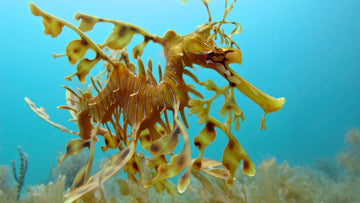To celebrate the arrival of the Year of the Dragon in China, we present to you, unless you already know it, another dragon, the Phycodurus eques or leafy sea dragon. We don't know if this fish, related to seahorses, is also associated with the strength, health, and harmony of the Chinese dragon. But after watching the video, it rather reflects fragility, calmness, and, above all, a unique mimetic ability.
The Leafy Dragon from Global Dive Media
Before we continue, for lovers of this spectacular animal, we have this leafy sea dragon poster, and we've designed a collection of seahorse t-shirts. Also perfect as a present :-)
This predator has managed to greatly resemble the algae that make up its environment, avoiding predators by hiding among the vegetation. Although they may look like fins, the protrusions of the dragon serve no motor purpose as it propels itself only with the pectoral fin and a dorsal fin near the tail; the rest of the fins are just part of the disguise. That long snout, which closely resembles the stem of algae, is what facilitates its feeding as it uses it to suck in zooplankton, fish larvae, and small crustaceans like shrimp.
 Photo Dive Gallery
Photo Dive GalleryLeafy sea dragons can only be found in sandy bottoms up to 50 meters in the waters of southern Australia, from Kangaroo Island to Jurien Bay 220 km from Perth. Populations of Phycodurus eques have been threatened by pollution and industrial waste but also by the excesses of some divers, indiscriminate hunting for sale to aquarium hobbyists, and even used in "alternative medicine" therapies. In response to these dangers, the leafy sea dragon is officially protected by the Australian government, which, however, allows controlled capture of some specimens.
Such is the admiration that this fish arouses in some parts of Australia that even a biennial on the environment, art, and culture is celebrated in the southern Fleurieu Peninsula, focused on the leafy sea dragon and attracts more than 7,000 participants and visitors.





















